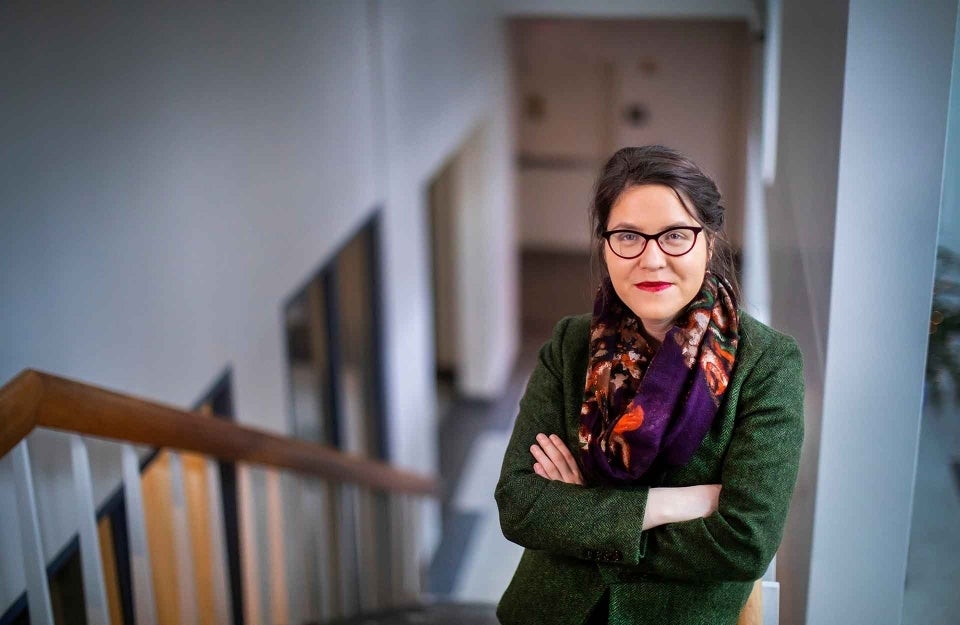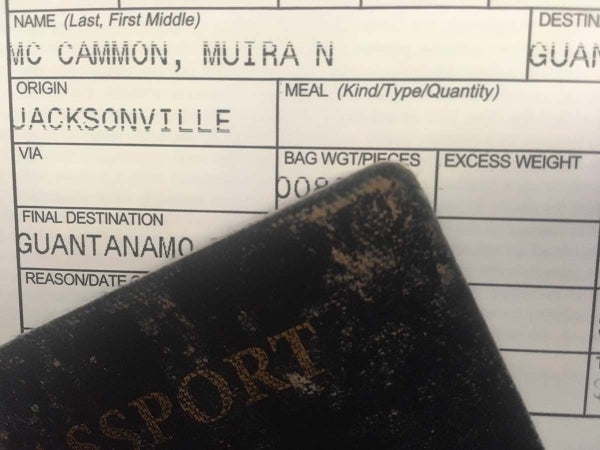Understanding How Information Flows Into and Out of Gitmo
Doctoral student Muira McCammon studies the intersection of technology, law, and military policy.

Muira McCammon (Photo Credit: Eric Sucar)
The United States detention center at Guantánamo Bay Naval Base has a library for detainees that includes thousands of books. Noam Chomsky’s Interventions isn’t one of them, something Penn doctoral student Muira McCammon learned when she was reading it for a master’s degree at the University of Massachusetts Amherst.
“I was taking a course on forbidden texts and I had assigned myself Chomsky,” she says. “At the time, as standard practice, I Googled every book that I read, so I Googled this one and the first thing I learned was that it had been banned at the Guantánamo Bay library.”
Rather than answering questions for her, learning this raised many more. “I’d read some of the reporting on the detention facility, but I had no idea there was a military-run library there,” explains McCammon, a third-year Ph.D. student at the Annenberg School for Communication and a master’s in law candidate at Penn Law.
“I’m a creature of libraries,” she says. “I immediately had thousands of questions. I was calling lawyers: How did the library there start? Who decided which books belonged there? And how have I never heard of it before? Later, new questions arose, like, ‘I’m calling this a library, but is it really a library if Gitmo detainees are never allowed to step foot inside it?’”

For McCammon, unearthing the existence of this library and its prohibited books led to her current study path, which focuses on the movement—both of information and people—into and out of military bases like Guantánamo Bay. “My primary interest is how information flows into these isolated and inaccessible spaces and also what it means to leave them,” she says. As part of this, she’s written articles on the subject for national media outlets and, with former Annenberg postdoc Daniel Grinberg and Annenberg alum Aaron Shapiro, produced a three-part podcast called “Gitmo Media” out of Penn’s Center for Media at Risk.
McCammon has been exploring these subjects for more than five years. At UMass Amherst, she was immersed in a field called translation studies, studying Turkish and concentrating on the rights of translators working in conflict zones, like Iraqi and Afghan citizens supporting U.S. military operations. She also worked as a research assistant for the Harvard Berkman Klein Center for Internet and Society on projects related to internet censorship. Right around that time, she discovered the Gitmo library.
Immediately, she tried to learn as much as she could about it. “At first, I wanted an inventory of all the books in the library. And it took time to realize that having that list doesn’t necessarily explain how the books got there,” McCammon says. “That lead me to reflect on the books that had been banned, donated by lawyers of detainees but not accepted by the U.S. government.”
"I was calling lawyers: How did the library [at Guantanamo] start? Who decided which books belonged there? And how have I never heard of it before?"
She began to think the only way to fully grasp what happens at the library was to see it firsthand. Initial attempts to secure a visit as an academic were turned down. She decided she might have better luck if she tried to go as a journalist instead, so she started pitching stories about Gitmo: For Slate, she wrote about what might happen to the fiber optic cables between Florida and Guantánamo should the naval base close. For Vice, she wrote about Pokémon Go and game culture at Gitmo.
In 2017, McCammon finally got to see in person the place she’d been writing about for months. “The library is the first major stop on the media tour there,” she says. “It was wild to be able to go, but going was also a reminder that the quest for facts is daunting and that in many ways the best way to explore Gitmo itself is to talk to the people who have left it.”
When she got back, she was still committed to learning and writing about Guantánamo, but she wanted to return to an academic setting to do it. That’s why she enrolled in two programs at Penn, a doctoral program at the Annenberg School for Communication and a master’s program in law.
Being back in academia has allowed McCammon to expand how she’s studying military bases. Part of her work now looks at the trajectory of detainees and guards who have gone through the facility, specifically, what life looks like after Gitmo. Her research also considers the images circulating about Guantánamo, how journalists working outside the U.S. cover it, and the role different federal agencies play in maintaining it.
And, given her experience writing journalistically about the naval base and detention center, she’s been thinking about the challenges that media practitioners face in telling stories about the facility. That last line of research led her to partner with Grinberg and Shapiro on a series of podcasts.
The first episode, “Documenting Detention,” features documentarian Johanna Hamilton, who directed a short film about the legal team of one Guantánamo detainee. In the second, “Visualizing Injustice,” the team interviews sketch artist Janet Hamlin about the challenges of visually representing the complexity of Guantánamo Bay’s military tribunals. In the third part, “Detainee Diary,” Mohamedou Slahi talks about what it was like to be held at Gitmo for 14 years.
“It’s critical for scholars and journalists to think about different ways to share stories with the world, especially when we are talking about detention facilities run by the U.S. Department of Defense and the U.S. Department of Homeland Security,” says McCammon.
She finds inspiration in many who have paved the way before her, like her Ph.D. advisor Barbie Zelizer, who runs the Center for Media at Risk, and Jessa Lingel, an Annenberg professor who has worked in and written about prison libraries. She also admires journalists like Margot Williams who helped create The New York Times’ “Guantanamo Bay Docket,” and Andrea Pitzer, who wrote “One Long Night.”
“There are so many other scholars whose writings have informed my understanding of prisons, surveillance, and military policy, like Simone Browne’s ‘Dark Matters: On the Surveillance of Blackness,’ a book that has really shaped how I situate my work on Gitmo,” she says.
Despite what she’s already done, the articles and podcast episodes she’s produced, McCammon feels she has much more to learn about and contribute to the topic.
“I’ve been treading carefully. Adopting an evidence-based approach is key, but when the U.S. government has made so many records inaccessible, it can be a challenge,” she says. “In particular, the legal-political obstacles placed on journalists who are trying to cover detention facilities have been at the forefront of my mind, and I’ve been thinking about the future of Guantánamo which, in many ways, is harder to parse.”



